Railways in War
Part 1 - Early organization and evolution1861-1865
1870-1871
1914-1918
How long was it ? ... perhaps a decade before the Wright brothers' transportation invention was used as a weapon of war ?
With Stephenson's first true railway in 1825 ... it was in 1842 that C.E. Ponitz and von Moltke were considering how railways could assist in the defence of Prussia and its allied Germanic states.

Lessons from the US Civil War
1861-1865
It is generally with the US Civil War that most books begin the history of the railway as a key asset in war. By 1861, America had a good system of railroads which were built mainly for commercial purposes. No one foresaw the particular geographical split between the Union and Confederate sides coming when the railroads were built. Generally these railroads were not built according to military or strategic plans.
On unpaved roads or over fields, an army can march perhaps 25 miles per day ? A railway of the era could get you over that distance in perhaps 2-3 hours AND the soldiers would be much peppier on arrival than if they had carried their equipment on a 25 mile hike. Along with transporting the soldiers, we must also consider moving the tents, blankets, field kitchen equipment, grain for the horsies, rations for soldiers, cannon, balls and powder, blacksmith's anvil and tools, etc. In a big place ... like the US during the Civil War ... tens or hundreds of miles would be covered to get to a battle.
These are the reasons why it became apparent to military leaders that they should consider using the railroads in an organized manner.
Problem : These were commercial American railroads with their own regular employees. The military has a 'different' way of doing things.
Before long, the Union side - which was more industrial and less agrarian than the South - set up specialized railroad troops. In the future ... up to the end of World War Two ... railway troops had three main responsibilities :
With Stephenson's first true railway in 1825 ... it was in 1842 that C.E. Ponitz and von Moltke were considering how railways could assist in the defence of Prussia and its allied Germanic states.
But we all know what the best defence is don't we ... Mein Herren ?
We'll be getting back to you before long.
We'll be getting back to you before long.

The German Confederation : 35 monarchies, 4 free states
... and more fun than a barrel of monkeys!
(Kids: That's just an old expression ... you should never put live monkeys in a barrel)
... and more fun than a barrel of monkeys!
(Kids: That's just an old expression ... you should never put live monkeys in a barrel)
Lessons from the US Civil War
1861-1865
It is generally with the US Civil War that most books begin the history of the railway as a key asset in war. By 1861, America had a good system of railroads which were built mainly for commercial purposes. No one foresaw the particular geographical split between the Union and Confederate sides coming when the railroads were built. Generally these railroads were not built according to military or strategic plans.
On unpaved roads or over fields, an army can march perhaps 25 miles per day ? A railway of the era could get you over that distance in perhaps 2-3 hours AND the soldiers would be much peppier on arrival than if they had carried their equipment on a 25 mile hike. Along with transporting the soldiers, we must also consider moving the tents, blankets, field kitchen equipment, grain for the horsies, rations for soldiers, cannon, balls and powder, blacksmith's anvil and tools, etc. In a big place ... like the US during the Civil War ... tens or hundreds of miles would be covered to get to a battle.
These are the reasons why it became apparent to military leaders that they should consider using the railroads in an organized manner.
Problem : These were commercial American railroads with their own regular employees. The military has a 'different' way of doing things.
Before long, the Union side - which was more industrial and less agrarian than the South - set up specialized railroad troops. In the future ... up to the end of World War Two ... railway troops had three main responsibilities :
1. Operate railways to effectively support military operations during war.
2. Repair damaged railway lines and rebuild destroyed railway structures.
3. Destroy railway assets effectively when the army withdraws to prevent them from being used by the enemy.
2. Repair damaged railway lines and rebuild destroyed railway structures.
3. Destroy railway assets effectively when the army withdraws to prevent them from being used by the enemy.
* * *
"I have seen the most remarkable structure that human eyes ever rested upon. That man Haupt has built a bridge across Potomac Creek, about 400 hundred feet long and nearly a hundred feet high, over which loaded trains are running every hour, and, upon my word ... there is nothing in it but beanpoles and cornstalks." Abraham Lincoln
The bridge in question (shown below) had been rebuilt in 72 hours.
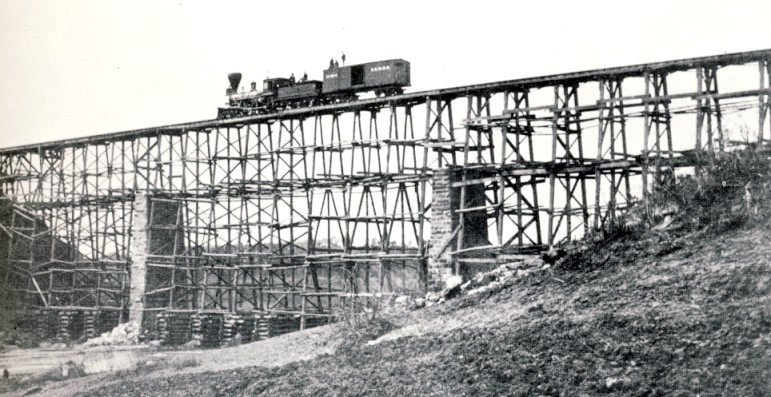
An engineer who wrote the classic textbook on bridge construction in 1851, Herman Haupt, was quickly put in charge of the Union's railroads during the Civil War. He also developed a corps of railway engineering professionals and effective techniques for both building and destroying railroads.
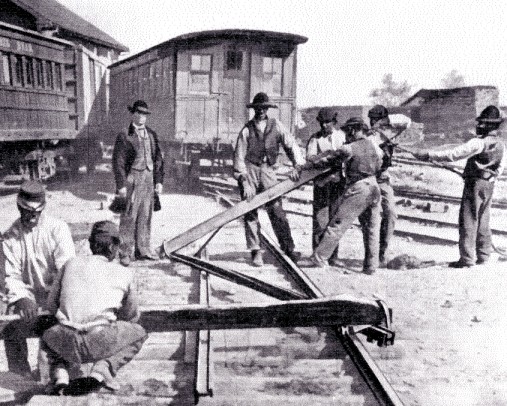
Here in the Haupt "laboratory" simple
effective tools to make rails unusable are being demonstrated. Put the horseshoe-like hooks
under the rail base at each end and insert railroad ties ... now
counter rotate ! Elsewhere in the yard, someone else is experimenting with simple
techniques to fix deformed rails - and it's not easy ! Destroying
Confederate rails was quite an effective tactic as most of America's
industrial capacity to re-roll rails was in the north.
Union General William Sherman and his troops displayed great virtuosity in their destruction of southern railway infrastructure during their punitive romp through Georgia later in the war. For a "Sherman Necktie" build a big fire under the middle of some torn-up rails ... then twist two rails around a tree in an "X" while the middle sections are red hot ... Soldiers can waste a lot of time and energy destroying railroad infrastructure if they are not properly supervised ...
Union General William Sherman and his troops displayed great virtuosity in their destruction of southern railway infrastructure during their punitive romp through Georgia later in the war. For a "Sherman Necktie" build a big fire under the middle of some torn-up rails ... then twist two rails around a tree in an "X" while the middle sections are red hot ... Soldiers can waste a lot of time and energy destroying railroad infrastructure if they are not properly supervised ...
Lessons from the Franco-Prussian War
1870-1871
When it came to organized violence on a
large scale, North Americans were amateurs ... considering the frequent
wars which European monarchs and/or despots inflicted on their fellow
humans. Napoleon's paradigm shift from small professional armies ... to
most males
having a compulsory military service requirement during war ... really spread the misery
around,
particularly when armies solved logistical supply problems by "living off the land (i.e. people)" they had conquered.
The Franco-Prussian War was declared by the French for no compelling reason ... it began at the French Alsace-Lorraine and German Empire border near 'Baden' on the map above ... and was finished by the Prussians in Paris. A significant historical outcome from the war was the uniting of the Germanic states into the nation of Germany under Prussian leadership.
The Prussians had massed their troops at various locations within their homeland. Once assembled, each unit travelled to military loading stations - Etappenanfangsort [take THAT spellchecker!] - and boarded assigned trains, with their equipment, under the command of the units' officers.
Why were the Germanic guys so organized and ready for this war ??
Remember, at the top of this page, the Prussians were considering the use of railways for "defence" way back in 1842 !
While Canada was busy being born in 1867, a Prussian committee of military staff and railway officials under von Moltke (AKA "Moltke the elder": the uncle of the future World War One military chief under the Kaiser), put together a Route Service Regulation which was kept secret until someone started the next war ... France in 1870.
It set out procedures for :
To ensure efficient organization, they had various bodies such as:
Central Commission; Executive Commission; Auxiliary Executive Commission; Line Commissions; District Line Commissions
Even with their good organization, the Prussians had some problems with their railway procedures, and subsequently made things even better for their next war.
Meanwhile in France ... soldiers were arriving at urban stations in Paris. If they were early, they got really drunk and their friends sometimes took their ammunition for souvenirs of the great event.
French trains left with or without :
Most trains were heading east for Metz or Strasbourg in Alsace-Lorraine. There and along the route, could soon be found groups of thousands of soldiers without commanding officers and without food. To make things more interesting, French railways back then were owned and operated by several different companies. There were other problems relating to poor officer leadership : e.g. whose job was it to get the men unloaded - the French Army officers or the railway staff ?

A French hospital train from the Franco-Prussian War.
There is some axle-belt driven equipment and clerestory windows brighten up the interiors with natural light.
The standard two-axle railway cars probably had a capacity of 8-10 tons.
Metz had 4 miles of yard track and 8 good unloading depots. The facility could unload 930 cars in 24 hours when things were done right.
The first troop trains arrived without orders ... were the soldiers supposed to get off and assemble somewhere?
Railways like to get goods to where they're going, right ? " Get everything to Metz fast ! ... this is war ! "
At Metz ... " Where do you want all this stuff unloaded ? "
With no plan for unloading and storage, trains of identical boxcars were placed on long yard tracks. More troops and supplies kept on coming.
" Where's the food? Where's our equipment?! "
As well, busy railways usually need their cars emptied and returned quickly.
But why should the army unload them if army units might suddenly be ordered somewhere else?
Anyway ... isn't it the railway's job to unload boxcars ?
This was also happening elsewhere on France's eastern border. In addition, all sorts of conflicting military orders were being sent from Paris.
Even though they were on steel wheels and easy to pull to safety ... 16,000 French Freight Cars and their Contents ... were captured by the Prussians. The latter spent the rest of the war enjoying both the goodies and the freight cars.
Many more carloads were saved only because the French railways stopped and reversed the traffic on their own.
The captured cars later ran up many 'interchange miles' on the German Eisenbahnen. After the war and the ceding of Alsace-Lorraine to Germany, the cars were ... eventually returned to France. The Alsace-Lorraine area was valuable to German industrial and military expansion ... being rich in iron ore, coal, and iron smelters.
The Franco-Prussian War was declared by the French for no compelling reason ... it began at the French Alsace-Lorraine and German Empire border near 'Baden' on the map above ... and was finished by the Prussians in Paris. A significant historical outcome from the war was the uniting of the Germanic states into the nation of Germany under Prussian leadership.
The Prussians had massed their troops at various locations within their homeland. Once assembled, each unit travelled to military loading stations - Etappenanfangsort [take THAT spellchecker!] - and boarded assigned trains, with their equipment, under the command of the units' officers.
Why were the Germanic guys so organized and ready for this war ??
Remember, at the top of this page, the Prussians were considering the use of railways for "defence" way back in 1842 !
While Canada was busy being born in 1867, a Prussian committee of military staff and railway officials under von Moltke (AKA "Moltke the elder": the uncle of the future World War One military chief under the Kaiser), put together a Route Service Regulation which was kept secret until someone started the next war ... France in 1870.
It set out procedures for :
1. Replenishing the army with men, horses, provisions, ammunition and other stores.
2. Transporting back into the interior of Prussia of the sick, wounded, prisoners and trophies of war.
3. Maintaining communication: railway, roads, bridges, telegraphs, postal services.
2. Transporting back into the interior of Prussia of the sick, wounded, prisoners and trophies of war.
3. Maintaining communication: railway, roads, bridges, telegraphs, postal services.
To ensure efficient organization, they had various bodies such as:
Central Commission; Executive Commission; Auxiliary Executive Commission; Line Commissions; District Line Commissions
Even with their good organization, the Prussians had some problems with their railway procedures, and subsequently made things even better for their next war.
* * *
Meanwhile in France ... soldiers were arriving at urban stations in Paris. If they were early, they got really drunk and their friends sometimes took their ammunition for souvenirs of the great event.
French trains left with or without :
- Complete military units assembled together - often units of infantry, artillery and cavalry were mixed together.
- Their commanding officers.
- Adequate rations and supplies on the same train as the soldiers.
Most trains were heading east for Metz or Strasbourg in Alsace-Lorraine. There and along the route, could soon be found groups of thousands of soldiers without commanding officers and without food. To make things more interesting, French railways back then were owned and operated by several different companies. There were other problems relating to poor officer leadership : e.g. whose job was it to get the men unloaded - the French Army officers or the railway staff ?
The railways did move a lot of traffic and I have calculated what was
statistically aboard the "average train" ...
for the first 600 trains dispatched east, July 16 to July 26, 1870.
for the first 600 trains dispatched east, July 16 to July 26, 1870.
| On the "average" French train 314 soldiers 54 horses 11 guns and road vehicles 7 freight car loads of ammunition and supplies |
Back then it took 19 days in total for the French to mass their troops
near their eastern border where the Prussians were expected to attack
...
300,000 soldiers, 64,700 horses, etc.
300,000 soldiers, 64,700 horses, etc.

A French hospital train from the Franco-Prussian War.
There is some axle-belt driven equipment and clerestory windows brighten up the interiors with natural light.
The standard two-axle railway cars probably had a capacity of 8-10 tons.
* * *
Besides keeping the soldiers organized
in their own units and fed,
the other big French Lesson for "next time" came from what happened at Metz (map below) ...
the other big French Lesson for "next time" came from what happened at Metz (map below) ...
Metz had 4 miles of yard track and 8 good unloading depots. The facility could unload 930 cars in 24 hours when things were done right.
The first troop trains arrived without orders ... were the soldiers supposed to get off and assemble somewhere?
Railways like to get goods to where they're going, right ? " Get everything to Metz fast ! ... this is war ! "
At Metz ... " Where do you want all this stuff unloaded ? "
With no plan for unloading and storage, trains of identical boxcars were placed on long yard tracks. More troops and supplies kept on coming.
" Where's the food? Where's our equipment?! "
As well, busy railways usually need their cars emptied and returned quickly.
But why should the army unload them if army units might suddenly be ordered somewhere else?
Anyway ... isn't it the railway's job to unload boxcars ?
This was also happening elsewhere on France's eastern border. In addition, all sorts of conflicting military orders were being sent from Paris.
Then, the
Prussians invaded Alsace-Lorraine ...
Even though they were on steel wheels and easy to pull to safety ... 16,000 French Freight Cars and their Contents ... were captured by the Prussians. The latter spent the rest of the war enjoying both the goodies and the freight cars.
Many more carloads were saved only because the French railways stopped and reversed the traffic on their own.
The captured cars later ran up many 'interchange miles' on the German Eisenbahnen. After the war and the ceding of Alsace-Lorraine to Germany, the cars were ... eventually returned to France. The Alsace-Lorraine area was valuable to German industrial and military expansion ... being rich in iron ore, coal, and iron smelters.
France, Belgium, Germany. Railway network circa 1900.
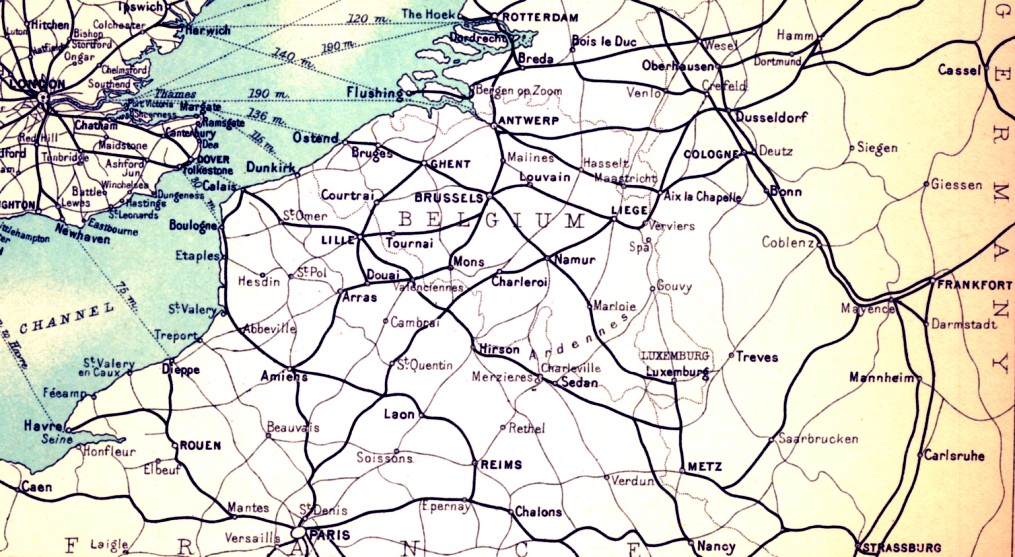
France, Belgium, Germany. Railway network circa 1900.
Between the Wars
Learning its lessons from the war,
France organized its own military railway corps and developed textbooks
and courses of study for them on all railway subjects. In peacetime
there was regular cooperation between the French railways and the
soldiers of the railway corps as they worked together
on the various lines ... with the military personnel rotating from sector to sector
for experience. In addition, a particular section of the railway
system was run solely by the army as a model, testbed, and training
ground. On the map, notice the "railway ring" around Paris ... This allowed wartime trains to
avoid the congestion of the urban railway lines AND permitted troops to
be quickly sent to points on the perimeter if Paris was threatened by
enemy troops during war.
The military general staff of the new state of Germany was keeping busy too. An ideal commercial railway network is shaped by commercial need and profitability ... but it must also confront the realities of the earth's topography. The German strategists had worked out that the ideal national strategic railway should be in the shape of a spider web. This ideal shape would allow excellent train dispatching from the central area of the state. It would also permit good lateral transport of troops near and along the border. Best of all, if the many lines radiated from the centre out to the state's border, the foreign enemy could be kept guessing WHERE along their border the troops would ultimately concentrate ... cross ... and attack.
Before World War One ... cleverly preparing for the last war, France fortified its eastern Alsace-Lorraine border with Germany. However, the Germans were quietly building up their rail system, including lines and facilities on the Belgian border to the north of France.
Besides appropriate "network topology", a true strategic railway must also have its own special "accessories" to be effective.
At the "railhead" (e.g. the border) where the war is to begin, there must be :
- Adequate tracks for storage and switching of freight cars.
And railway infrastructure to support iron horses and the necessary railway
support personnel.
- Ramps for efficiently loading and unloading wheeled equipment, horses and men.
- Troop
shelters and/or well-drained areas for tents, with adequate water
supplies and food preparation arrangements, and facilities for horses.
- Some storage capacity, e.g. warehouses and magazines ... for stockpiled supplies and ammunition.
- Advanced communication facilities, e.g. to receive troop movement orders from headquarters and to report on readiness for the attack.
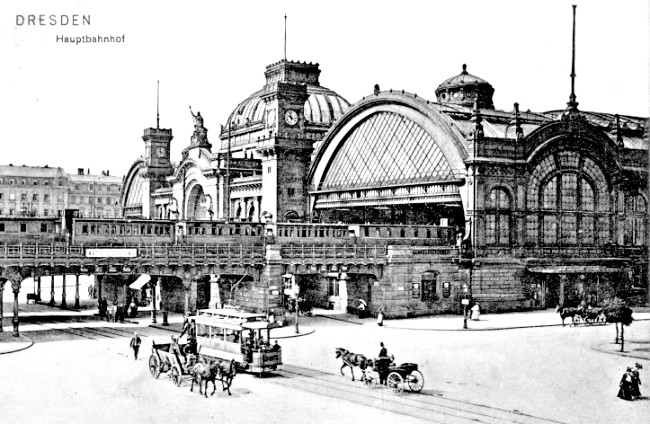
An example of Germany's well-developed civilian railway infrastructure:
Dresden's railway station before World War One
Dresden's railway station before World War One
Railways in World War One
1914-1918
Germany's Western Front
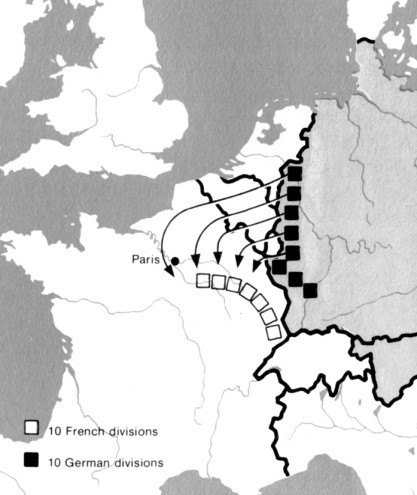
Above is a very simplified illustration of the Germans' Schlieffen Plan (1906).
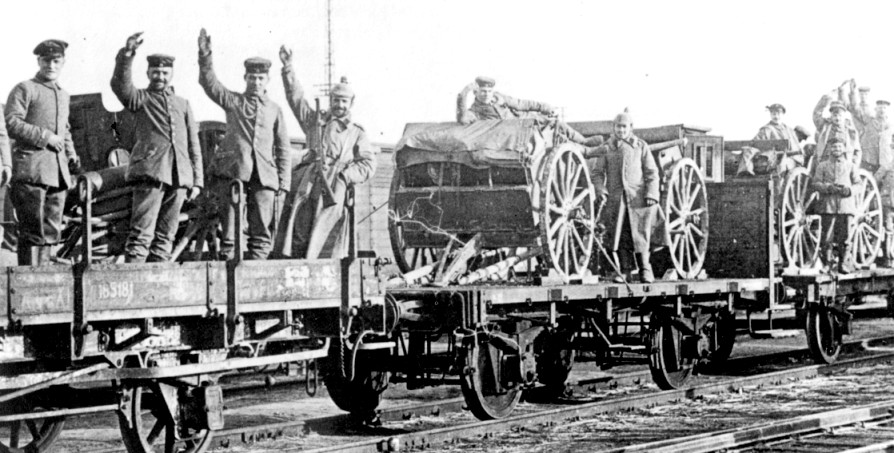
Oh, it's all fun and games until someone gets hurt !
German gunners pose with their equipment before the locomotive begins to pull.
On a war footing, the trains operated at 10 minute intervals (on "10 minute blocks").
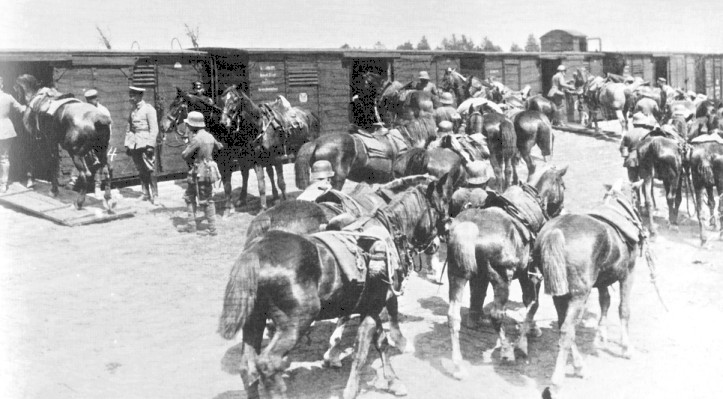
Horses in beautiful condition from an artillery regiment are loaded for their trip.
Notice the floor level of the cars matches the loading ramp.
The Germans had these things well organized.
This was probably taken later in the war ... compare the headgear in the two photos.

With the failure of Moltke's Schlieffen Lite ... NOT beating the French and NOT occupying Paris ...
After several months the Germans were ordered to fall back to high ground which could be defended and dig in.
The absurd golden age of Trench Warfare was beginning.
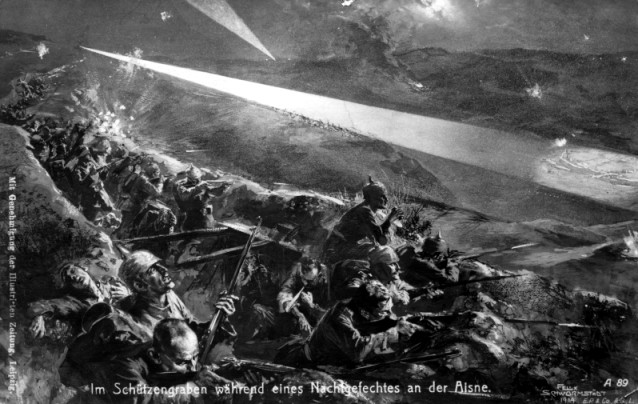
Early in the development of World War One Trenches :
In mid-September 1914, the Germans began to dig in north of the Aisne River (shown on the following map)
with a commanding view of the river valley below ... A spotlight shines over to the far bank of the river in this postcard art.
From their crude trenches on the high ground, and with heavy artillery support, the Germans
fought off any advances made against their positions by the British Expeditionary Force and the French Army.
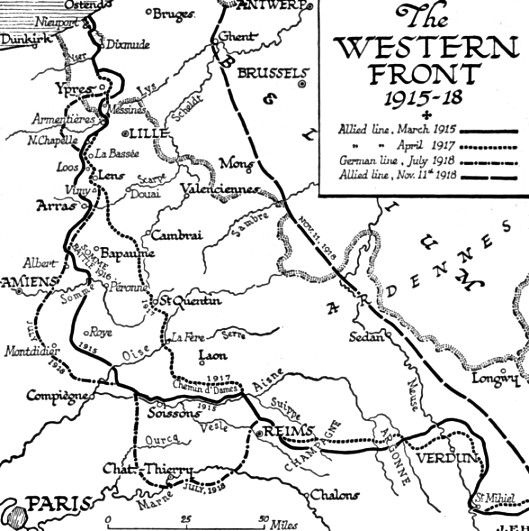
The map above shows the northern half of the 500 miles of continuous ditches the armies occupied in for most of the war.
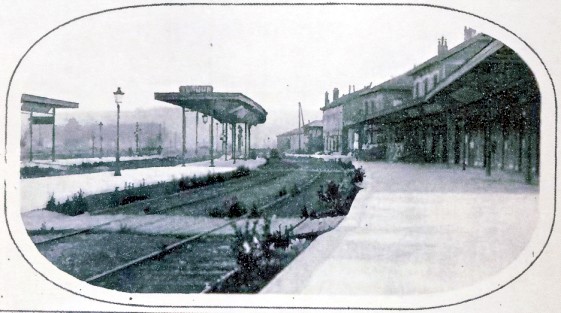
The commercial railway routes of peacetime were cut by the war.
At Verdun in the summer of 1916, the large railway facility is deserted and becoming overgrown with weeds.
A very brief moment of happiness
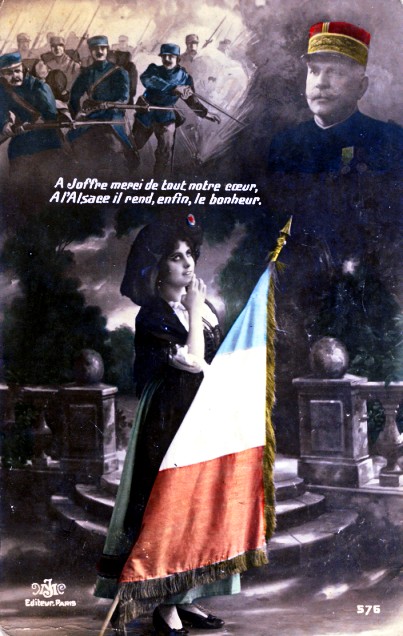
1914-1918
Germany's Western Front
The following comes from Barbara Tuchman's The Guns of August - a classic historical account of the opening days of the Great War ...
"Build
no more fortresses, build railways," ordered the elder Moltke who had
laid out his strategy on a railway map and bequeathed the dogma that
railways are the key to war. In Germany the railway system was under
military control with a staff officer assigned to every line; no track
could be laid or changed without permission of the General Staff.
Annual mobilization war games kept railway officials in constant
practice and tested their ability to improvise and divert traffic by
telegrams reporting lines cut and bridges destroyed. The best brains
produced by the War College, it was said, went into the railway section
and ended up in lunatic asylums.

Above is a very simplified illustration of the Germans' Schlieffen Plan (1906).
The secret Schlieffen Plan was named after the
Chief of the German General Staff from 1891 until his retirement in
1906 .. Count Alfred von Schlieffen. With France and Russia in a
military alliance, and with Belgium's (and tiny perfect Luxembourg's) neutrality guaranteed by Britain and others
... it was ass.u.me.d that in a future war France would engage
Germany through Alsace-Lorraine.
Being good planners and also very tricky, the Germans would NOT plan to meet France in Alsace-Lorraine, but would sweep through neutral Belgium and northern France and take Paris. Then they would "roll up the Left Flank" of the French army and force their surrender. Because (France's ally) Russia's military was less efficient and had greater distances to travel ... it was planned that a skeleton German force would hold them at the east end of Prussia for about 6 weeks.
On the map above, the army of German black squares above would finish off the army of French white squares ... then hop back on the strategic military railways of Germany, and whip east completely across Germany to engage and defeat the Russians.
So Germany was stuck with a two-front war as it was sandwiched between allies France and Russia. Successfully defeating the French first and then defeating the slower Russians - as they came to France's aid - was the only way Germany could win. As large as it was, even the German Army had its limits.
| Belgian Neutrality:
Belgium could have been a springboard for an invasion of Britain : e.g. by Germany or France.
Inspired by a close call with Napoleon, England got France, Russia, Prussia and Austria to sign a treaty in 1839 to ensure Belgium's perpetual neutrality. The treaty was still in effect when Germany attacked France through Belgium ... violating the terms of the 75 year old treaty. |
Being good planners and also very tricky, the Germans would NOT plan to meet France in Alsace-Lorraine, but would sweep through neutral Belgium and northern France and take Paris. Then they would "roll up the Left Flank" of the French army and force their surrender. Because (France's ally) Russia's military was less efficient and had greater distances to travel ... it was planned that a skeleton German force would hold them at the east end of Prussia for about 6 weeks.
On the map above, the army of German black squares above would finish off the army of French white squares ... then hop back on the strategic military railways of Germany, and whip east completely across Germany to engage and defeat the Russians.
So Germany was stuck with a two-front war as it was sandwiched between allies France and Russia. Successfully defeating the French first and then defeating the slower Russians - as they came to France's aid - was the only way Germany could win. As large as it was, even the German Army had its limits.
The Germans' war was planned to be very dependent on German railway technology ... and their army ... and
the Schlieffen Plan working.
|
To move one German army corps -
(or just 2.5% of the German Army) it took this many railway cars : Officers 170 cars Infantry 965 cars Cavalry 2960 cars Artillery 1915 cars ... in 140 trains Average train length 42 cars.
And it took the same number of cars
- about 6000 - to transport all of their supplies. |

Oh, it's all fun and games until someone gets hurt !
German gunners pose with their equipment before the locomotive begins to pull.
On a war footing, the trains operated at 10 minute intervals (on "10 minute blocks").

Horses in beautiful condition from an artillery regiment are loaded for their trip.
Notice the floor level of the cars matches the loading ramp.
The Germans had these things well organized.
This was probably taken later in the war ... compare the headgear in the two photos.
General Helmuth von Moltke - the nephew of the more talented von Moltke 'the elder' who said 'build no more fortresses, build railways etc. etc.',
- succeeded Schlieffen as Chief of the German General Staff. After
problems with some of the execution of Schlieffen Plan ... and being unable to
stay in contact and command his armies advancing through Belgium and
France ... he knew that the war was lost just hours after it began.
Dying in 1916, he did not live to see the war's final outcome.
Part of the problem was the Day One interference of the supreme leader, the emperor of Germany - Kaiser Wilhelm II - the eldest grandson of Queen Victoria. The other problem was that the attacking right of the German forces was not strong enough to sweep and occupy Belgium and France all the way to the English Channel. Moltke had done "Schlieffen Lite" in spite of Schlieffen's legendary dying words to "Keep the right strong". The French were NOT contained and defeated as planned ... AND short distance cross-channel support and reinforcement of the small British Expeditionary Force already in France, would continue for the next four years until the Armistice.
Part of the problem was the Day One interference of the supreme leader, the emperor of Germany - Kaiser Wilhelm II - the eldest grandson of Queen Victoria. The other problem was that the attacking right of the German forces was not strong enough to sweep and occupy Belgium and France all the way to the English Channel. Moltke had done "Schlieffen Lite" in spite of Schlieffen's legendary dying words to "Keep the right strong". The French were NOT contained and defeated as planned ... AND short distance cross-channel support and reinforcement of the small British Expeditionary Force already in France, would continue for the next four years until the Armistice.
Not enough MIGHT in the RIGHT for the Germans ...
Using military terminology : in both advancing and retreating, the German RIGHT
is always on the right hand side of the original advancing army.
So the French LEFT is represented by the closest unit to Paris on this map.
Using military terminology : in both advancing and retreating, the German RIGHT
is always on the right hand side of the original advancing army.
So the French LEFT is represented by the closest unit to Paris on this map.

With the failure of Moltke's Schlieffen Lite ... NOT beating the French and NOT occupying Paris ...
After several months the Germans were ordered to fall back to high ground which could be defended and dig in.
The absurd golden age of Trench Warfare was beginning.

Early in the development of World War One Trenches :
In mid-September 1914, the Germans began to dig in north of the Aisne River (shown on the following map)
with a commanding view of the river valley below ... A spotlight shines over to the far bank of the river in this postcard art.
From their crude trenches on the high ground, and with heavy artillery support, the Germans
fought off any advances made against their positions by the British Expeditionary Force and the French Army.

The map above shows the northern half of the 500 miles of continuous ditches the armies occupied in for most of the war.

The commercial railway routes of peacetime were cut by the war.
At Verdun in the summer of 1916, the large railway facility is deserted and becoming overgrown with weeds.
A very brief moment of happiness

This "out of date" postcard was sent from St. Pierre Eglise in September 1915.
Joffre was Commander in Chief of the French Army for the first two years of the war.
Contrasting with the intricate Schlieffen Plan ... France's strategy :
Plan 17 simply stated they would grab back Alsace-Lorraine, avenging its loss in 1871.
At first, Joffre could not believe that Moltke had enough troops - both to invade through Belgium to the north ... and defend Alsace-Lorraine to the east.
Joffre's forces battled east for a short while in August 1914 - through Alsatian field and forest with high losses.
Then the French had to forget about liberating the rest of Alsace-Lorraine for the balance of the war.
Rapidly re-deploying armies north by railway to meet the invaders coming through Belgium ...
Joffre, the French, and the BEF barely prevented the southbound Germans from taking Paris.
Alsace-Lorraine was returned to France after World War One
... at least until the next war came along.
Back to sitemap